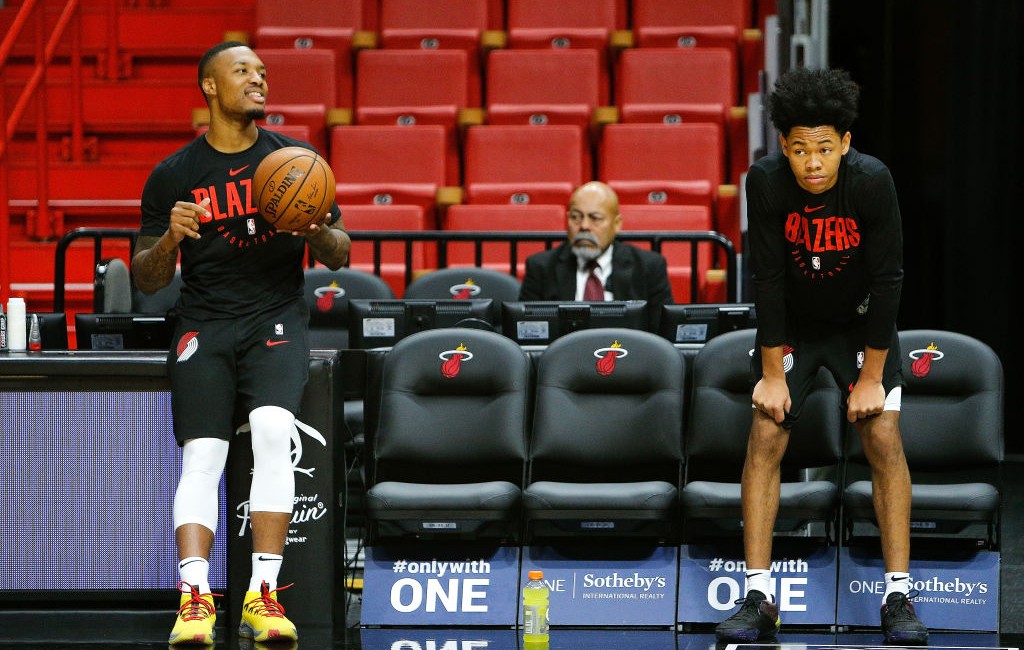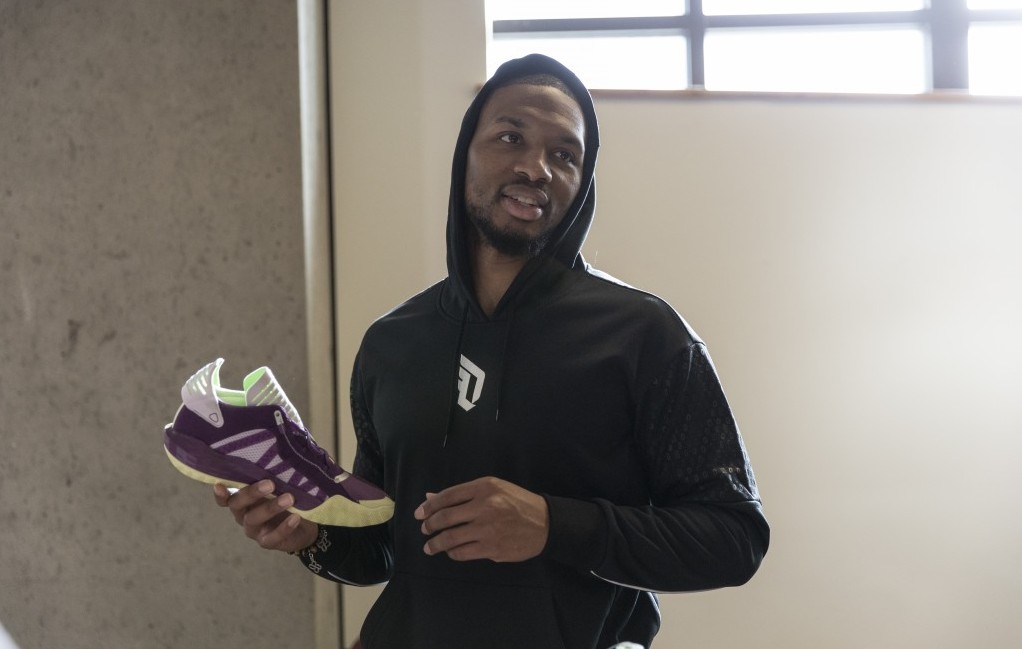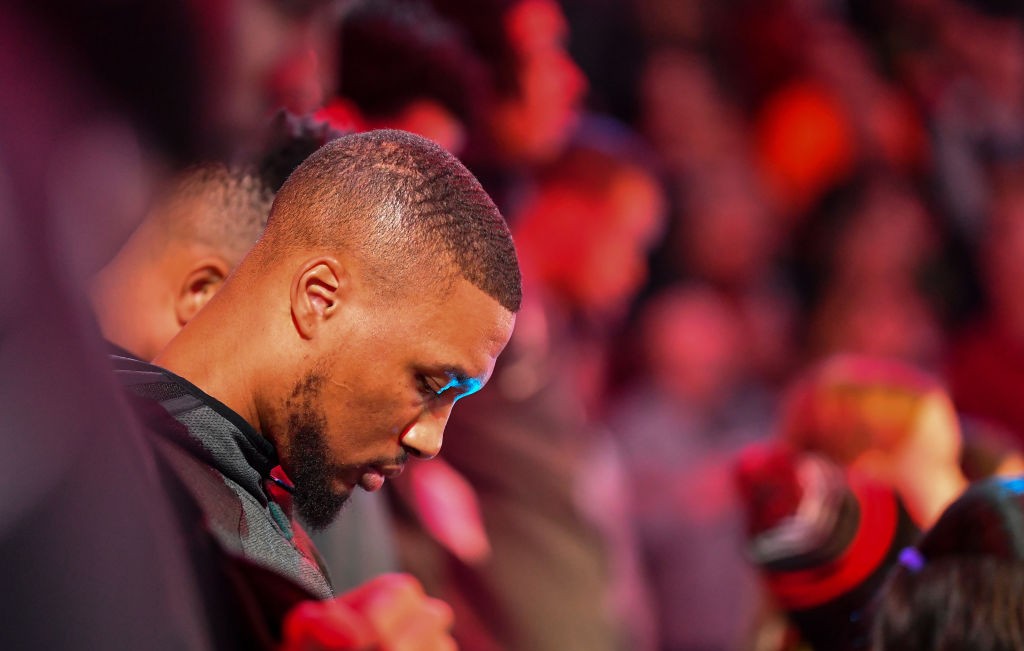PORTLAND – Despite scoring nine points on 2-for-12 shooting in a loss to the Raptors and showing frustration on his face throughout mid-November, when Damian Lillard sees his son — still bouncy after 10 p.m. — he lights up. Dame Jr., at a year and a half, has the same never-ending energy his dad does, stomping his feet with a mock scowl, climbing Lillard and trying to grab his chain, and doing his own version of sprints in the bottom of the Moda Center.
Lillard still has a championship on his mind, but he’s never been two-dimensional. As he says in “Baggage Claim” (on his latest album Big D.O.L.L.A.), “28 and rich, I’m in my prime.” Dame’s now 29, a superstar in the middle of a supermax deal. He also boasts guest features from Jeremih and Lil Wayne on his album, the sixth version of his signature adidas shoe dropping on Black Friday, a son who already takes after his dad, and the entire Pacific Northwest seemingly behind him.
“None of it is random,” Lillard says as he looks over each edition of his Dame shoe line from 1 to 6 in downtown Portland. “It’s all been a process together.”
If he can’t enjoy his prime and celebrate the work it took to get there, then what was that work for in the first place? Lillard’s career has been filled with underdog moments, but now that he’s firmly one of basketball’s giants, it’s okay to flex a little bit. This moment, as every moment before, and every moment since, is a collective effort for Lillard and those in his life who helped get him where he is. Sure, there will be those trying to knock him off the heap, but if he can’t breathe in the mountain air at the summit, the climb loses a bit of its meaning.
“That’s where my strength is because I don’t try to be something I’m not,” Lillard says. “I don’t say stuff that I don’t think. Whenever I think something or I feel a way about something, that’s what I say. If there’s something that I experienced that made me a certain way, that’s just what it is. That’s who I am. I’ve come this far being this way, so I don’t have any reason to be anything else.”
***
BE STILL OUR HEARTS 🥰😍 @Dame_Lillard + Dame Jr pic.twitter.com/x1laJRMtTQ
— Portland Trail Blazers (@trailblazers) November 28, 2019
When Lillard was a kid, his grandmother always used to drink Diet Coke. Naturally, as kids do, Dame and his cousins would sit around her, vying for attention, and if she had some Diet Coke, they’d want some too. Lillard’s grandmother allowed Dame and his cousins to “sip and pass,” where she’d take a sip, give it to one of the kids, and each one would take a turn getting to drink some before it would come back around to grandma.
If she decided she wanted the rest, at least everyone got some. If she only wanted a bit more, the glass would make its way around again. The important thing was that nobody went without a sip.
Naturally, that memory and that mindset have made its way into Lillard’s ascension. He won’t do anything without his family getting a taste. He won’t allow himself to be the end-all, be-all in creative discussions without collaborating. He won’t make an album without input. And he’s not going to have a big game without getting his teammates involved.
It shows in the way he deals with a young player like Anfernee Simons. Lillard took Simons under his wing almost immediately, the same way veterans like Ronnie Price, or Earl Watson, or Mo Williams did for Dame. The Blazers are rightfully high on Simons, and Lillard relishes the chance to give him every opportunity to be the best version of himself. Even if there’s a game where Dame wants most of the glass, he’ll do what he can to make sure Simons gets a sip.
“I’ll feel good about him doing well and knowing that I shared and pushed him and brought him along.” Lillard says. “And I played a role in what his story or what his process is. And once he turns 29 or 30 he’ll be doing it for somebody else and he’ll be doing it the right way for somebody else, and that’s having an impact. He’ll also respect me on a different level, once he realizes what my role was with him when he was 19, 20 years old.”

One thing that’s clear about Lillard is there isn’t anything he says or does without intent. In high school, he and his friends came out to their own music in layup lines. The organizations like Special Olympics he’s chosen to contribute to have been in his life for years. And now he has a platform, and the resources, to draw attention to those things his way. This was always in the DNA of Damian Lillard the person, even if Damian Lillard the basketball player created that opportunity.
“You just keep it a part of you,” Lillard says, “and just how you carry stuff. Even simple stuff is telling the story of where I come from. When the people who this represents, when they see it, it’s a different feeling for them because they feel accomplished, and acknowledged in the fact that they play where I come from, the people that I grew up around, and learn stuff from, and was challenged, and pushed by. They played a part in me becoming what I’ve become. Even though they might not get credit, and you don’t find them in this poster, and you won’t find their name on the internet or anything like that, but they played a part. So it’s little and small ways to show appreciation, keep that being a part of you, because that’s what really counts.”
Every colorway, or special edition, of the Dame shoe he releases has a story that weaves its way into something specific that happened to himself and those in his life — and can be a reflection of a bunch of other people who shared that experience. If anything, it’s a hat tip to those who built him up from the jump, and a subtle message to those who share the same experiences he’s had.
“I take a lot of pride in it,” Lillard says. “Knowing that it’s a lot of people who share my background, and share the way that I feel about stuff, and they don’t have the platform that I have to share, or to shine a light on it. But when you do, and you actually use it for those reasons, you shine the light for so many other people. And that’s how I see it. That’s why when I’m telling stories through my shoes, I tell real stories that a lot of people are going to be able to connect with. And sometimes the people that it’s connecting with aren’t going to be mainstream people, but it’s going to be some people who see, okay, he made a shoe about the streetlights, and getting home before the streetlights come on. Somebody that’s from the suburbs, or somebody that grew up in a cul-de-sac, they won’t be able to connect with growing up in the neighborhood, and when the street lights come on, that means it’s time to come home.
“But there’s millions of other people that will, and when that story is told, and when it comes to life, people will be drawn to that, because I’m connecting with that group of people,” Lillard continues. “That’s why you take the time to tell those stories and I think that’s why they’re so powerful.”

When Lillard comes into a meeting, his creativity shows through. He arrives prepared, and takes the same mindset he takes on the floor into a conference room. He’ll have ideas ready to go, and there’s logic behind them. There’s rationale. He’s not just doing something because it seems like it’d be fun to do; he pushes for ideas because they speak to him, and there’s a piece of himself in the execution. A lot of players throw around the word authenticity. For Lillard, it’s hard to imagine him being anything but.
“Dame is exactly what you see,” adidas director of footwear Cam Mason says. “Like he’ll tell you straight up front how he’s feeling, what he likes and doesn’t like, what he wants to see, what he doesn’t want to see. And I mean the blunt and straightforwardness is exactly what allows us to at least get our ideas out. Good or bad, he’ll let you know straight up. And I think that’s kind of how it evolved into from the 4 to 5 to the 6. And that’s kind of how the evolution of the shoe, starting with the 6, it’s like a new Dame.”
Jimi Taylor, adidas senior footwear designer, agrees.
“There’s this surface to Dame,” Taylor says. “But then the real layers, they’re all just stacked beneath that. And it’s like he would just have ideas, but then he can really unpack them with you, and talk about how he wants them to roll out, how he wants it to look, why he’s doing it in a certain way. And for me as a designer, that’s just such a rich starting point. I rarely feel like I have to draw things out with him.”
***
And that’s the bottom line, because @Dame_Lillard said so. pic.twitter.com/JvIMyoVkJQ
— Portland Trail Blazers (@trailblazers) October 23, 2018
So much of Lillard’s “show don’t tell” mindset, and his ability to channel his emotions into pure energy, comes from a simple source: professional wrestling. Lillard grew up a fan of Stone Cold Steve Austin (and even dressed up as him for Halloween in 2018), The Rock, Ric Flair, and Macho Man Randy Savage. It wasn’t just that they’d kick your ass, it’s that they’d tell you they were going to kick your ass and then go out and do it. It’s why Lillard has always been drawn to boxing as well, and why he works with boxing trainer Cem Eren (who calls Dame’s mindset just “like a fighter”) at Gem Fitness in the offseason.
The event itself has an allure, but the build-up and the preparation and the promos and the trash talk are an event in and of themselves.
“I always loved wrestling,” Lillard says. “And the weird thing is, I love the entertainment part of wrestling. Like the match was never the most fun part to see. It was when Ric Flair is up there, just on a rant for five minutes. Like that was my favorite part. And the walkout and just the entertainment part was always the most fun part to me. It wasn’t the actual match. It seemed like the match was when the whole show died down like are they actually fighting now, and it’s whatever. Like you don’t care about that. You care about what they wardrobe is, what they said in their interview, what they’re known for. Undertaker rolling his eyes back, the tombstone and caskets and all that stuff. It’s always been what I was interested in. So it fits perfect. The storylines.”
In today’s NBA, superstars still have an appeal, but even the last guy on the bench can make a name for himself by showing who he is, and connecting with fans on a deeper level than highlights. Social media has played a part, but so has players’ willingness to show themselves beyond shoes and what soda they drink. In that way, non-basketball fans can get involved as well. If you’re a huge gamer, there’s a player like Karl-Anthony Towns for you. Rap fans can gravitate towards Lillard for his skills on the mic. Some guys like craft beer, others are into fashion.
The league is a living, breathing organism like any other office, except that each of these individuals has the platform and the voice to make an impact and to influence others. In some ways, it’s just scratching the surface of the connections that can be made between a fan and a player, but it comes back to the entertainment aspect of it, and the ability to put one’s self in a player’s shoes — the same thing that drew Lillard to promotions like WWE. And it’s the same reason he notes how important every interaction is with the next generation.

“I can get on my Instagram live right now and I guarantee you it’ll be a 12-year-old on there like ‘add me’ and I can literally add him and we can be on Live talking,” Lillard says, “and all of my millions of followers is going to watch me talk to this kid. They live for stuff like that. So it’s just different. Imagine if I could go Live with 2 Pac as a kid. I would’ve been going crazy. That’s just crazy, if that was possible.”
12-year-old Dame obviously didn’t have Instagram, but he was trying to get home before the streetlights came on. 12-year-old Dame was trying to get a sip. 12-year-old Dame pretended to be Stone Cold. 12-year-old Dame dreamt of becoming a hooper and a rapper.
As 29-year-old Dame says, none of it is random.
Uproxx was hosted by adidas as part of the reporting on this piece. However, adidas did not review or approve this story in any way. You can find out more about our policy on press trips/hostings here.







